Management Law Report: Canadian Charter of Rights, Divorce, Taxation
VerifiedAdded on 2022/08/20
|11
|2680
|23
Report
AI Summary
This report examines Canadian management law, focusing on the Canadian Charter of Rights and Freedoms and its application to taxation policies and divorce cases. It presents two scenarios: the first involves a proposed tax reform impacting wealth distribution and its potential violation of charter rights, particularly freedom of expression and equality. The second scenario analyzes a prenuptial agreement in a divorce case, exploring spousal support guidelines and the impact of the length of the marriage and economic disadvantage. The report references legal precedents and charter sections to support its arguments, concluding that the proposed tax reforms may be challenged under the charter, and the prenuptial agreement's validity depends on the specific circumstances of the divorce. The report highlights the importance of the Charter of Rights in protecting individual freedoms and ensuring equal treatment under the law.
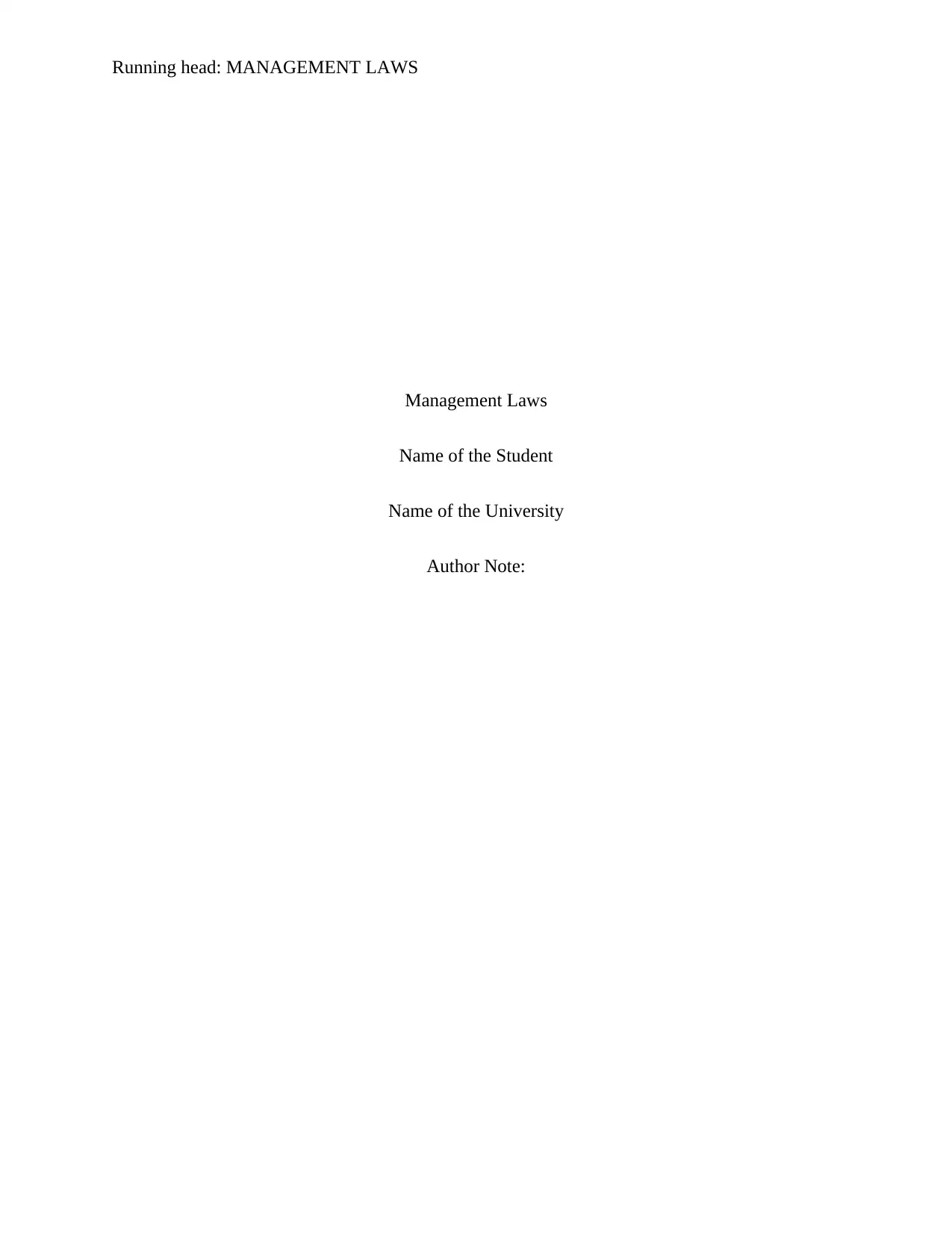
Running head: MANAGEMENT LAWS
Management Laws
Name of the Student
Name of the University
Author Note:
Management Laws
Name of the Student
Name of the University
Author Note:
Paraphrase This Document
Need a fresh take? Get an instant paraphrase of this document with our AI Paraphraser
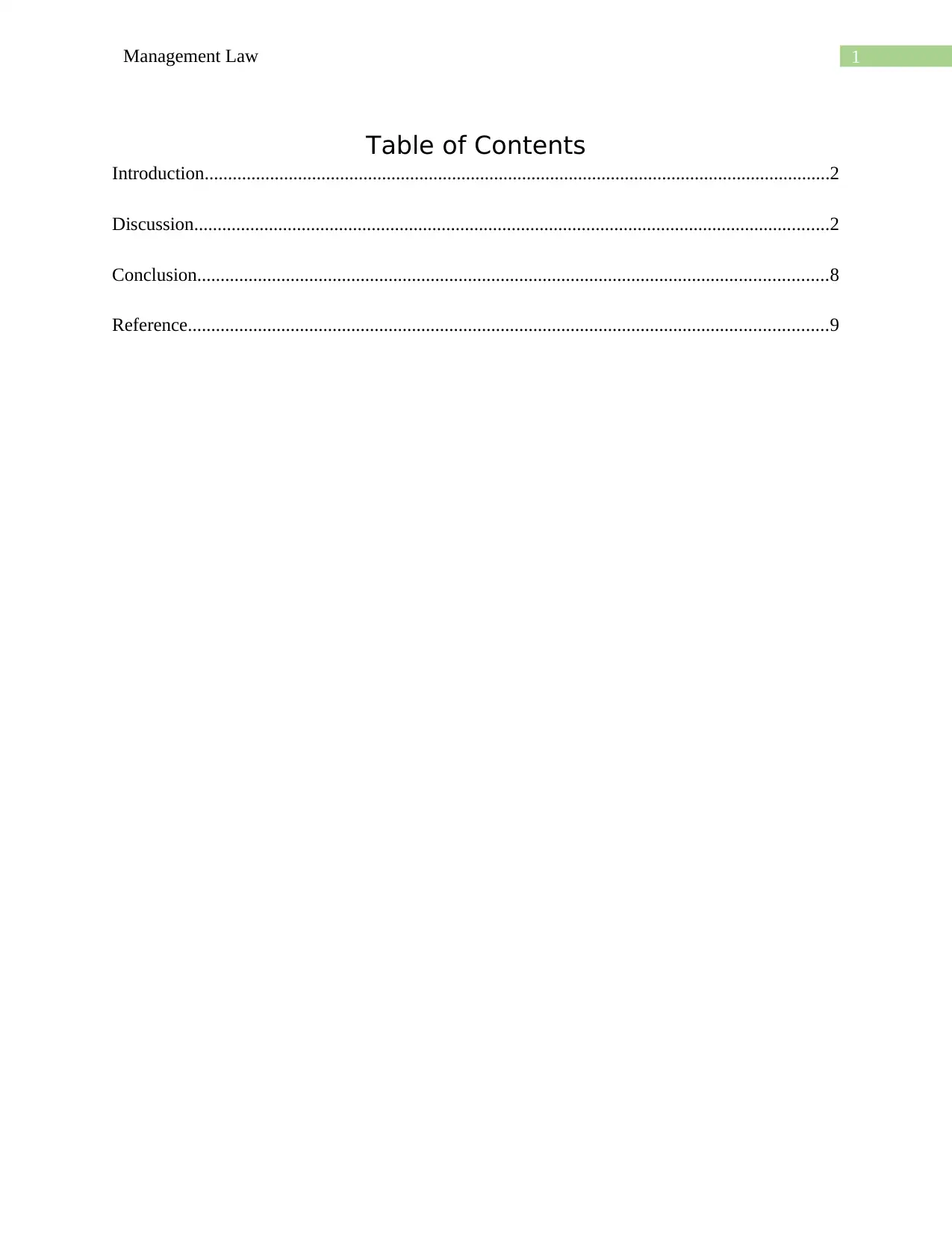
1Management Law
Table of Contents
Introduction......................................................................................................................................2
Discussion........................................................................................................................................2
Conclusion.......................................................................................................................................8
Reference.........................................................................................................................................9
Table of Contents
Introduction......................................................................................................................................2
Discussion........................................................................................................................................2
Conclusion.......................................................................................................................................8
Reference.........................................................................................................................................9
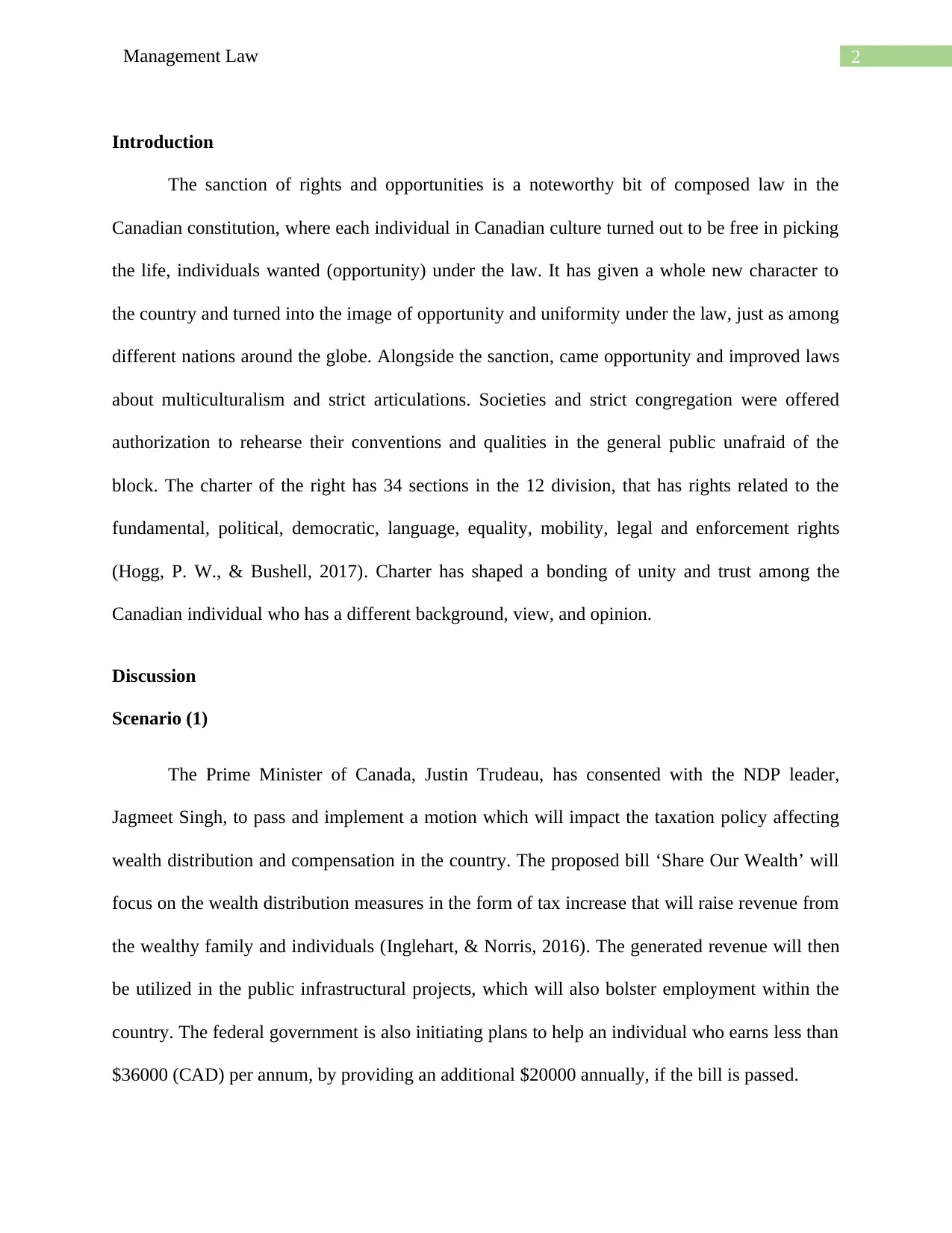
2Management Law
Introduction
The sanction of rights and opportunities is a noteworthy bit of composed law in the
Canadian constitution, where each individual in Canadian culture turned out to be free in picking
the life, individuals wanted (opportunity) under the law. It has given a whole new character to
the country and turned into the image of opportunity and uniformity under the law, just as among
different nations around the globe. Alongside the sanction, came opportunity and improved laws
about multiculturalism and strict articulations. Societies and strict congregation were offered
authorization to rehearse their conventions and qualities in the general public unafraid of the
block. The charter of the right has 34 sections in the 12 division, that has rights related to the
fundamental, political, democratic, language, equality, mobility, legal and enforcement rights
(Hogg, P. W., & Bushell, 2017). Charter has shaped a bonding of unity and trust among the
Canadian individual who has a different background, view, and opinion.
Discussion
Scenario (1)
The Prime Minister of Canada, Justin Trudeau, has consented with the NDP leader,
Jagmeet Singh, to pass and implement a motion which will impact the taxation policy affecting
wealth distribution and compensation in the country. The proposed bill ‘Share Our Wealth’ will
focus on the wealth distribution measures in the form of tax increase that will raise revenue from
the wealthy family and individuals (Inglehart, & Norris, 2016). The generated revenue will then
be utilized in the public infrastructural projects, which will also bolster employment within the
country. The federal government is also initiating plans to help an individual who earns less than
$36000 (CAD) per annum, by providing an additional $20000 annually, if the bill is passed.
Introduction
The sanction of rights and opportunities is a noteworthy bit of composed law in the
Canadian constitution, where each individual in Canadian culture turned out to be free in picking
the life, individuals wanted (opportunity) under the law. It has given a whole new character to
the country and turned into the image of opportunity and uniformity under the law, just as among
different nations around the globe. Alongside the sanction, came opportunity and improved laws
about multiculturalism and strict articulations. Societies and strict congregation were offered
authorization to rehearse their conventions and qualities in the general public unafraid of the
block. The charter of the right has 34 sections in the 12 division, that has rights related to the
fundamental, political, democratic, language, equality, mobility, legal and enforcement rights
(Hogg, P. W., & Bushell, 2017). Charter has shaped a bonding of unity and trust among the
Canadian individual who has a different background, view, and opinion.
Discussion
Scenario (1)
The Prime Minister of Canada, Justin Trudeau, has consented with the NDP leader,
Jagmeet Singh, to pass and implement a motion which will impact the taxation policy affecting
wealth distribution and compensation in the country. The proposed bill ‘Share Our Wealth’ will
focus on the wealth distribution measures in the form of tax increase that will raise revenue from
the wealthy family and individuals (Inglehart, & Norris, 2016). The generated revenue will then
be utilized in the public infrastructural projects, which will also bolster employment within the
country. The federal government is also initiating plans to help an individual who earns less than
$36000 (CAD) per annum, by providing an additional $20000 annually, if the bill is passed.
⊘ This is a preview!⊘
Do you want full access?
Subscribe today to unlock all pages.

Trusted by 1+ million students worldwide
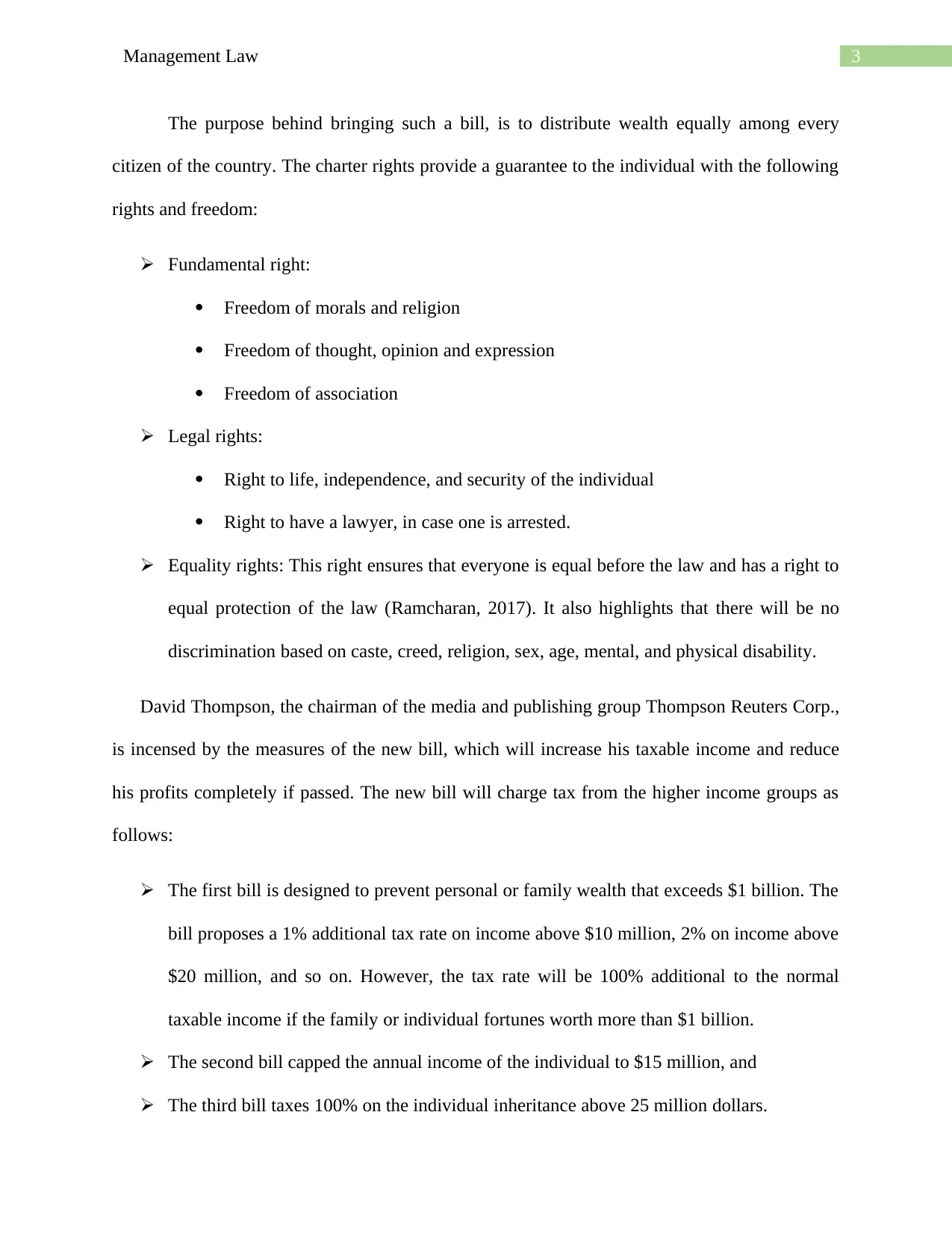
3Management Law
The purpose behind bringing such a bill, is to distribute wealth equally among every
citizen of the country. The charter rights provide a guarantee to the individual with the following
rights and freedom:
Fundamental right:
Freedom of morals and religion
Freedom of thought, opinion and expression
Freedom of association
Legal rights:
Right to life, independence, and security of the individual
Right to have a lawyer, in case one is arrested.
Equality rights: This right ensures that everyone is equal before the law and has a right to
equal protection of the law (Ramcharan, 2017). It also highlights that there will be no
discrimination based on caste, creed, religion, sex, age, mental, and physical disability.
David Thompson, the chairman of the media and publishing group Thompson Reuters Corp.,
is incensed by the measures of the new bill, which will increase his taxable income and reduce
his profits completely if passed. The new bill will charge tax from the higher income groups as
follows:
The first bill is designed to prevent personal or family wealth that exceeds $1 billion. The
bill proposes a 1% additional tax rate on income above $10 million, 2% on income above
$20 million, and so on. However, the tax rate will be 100% additional to the normal
taxable income if the family or individual fortunes worth more than $1 billion.
The second bill capped the annual income of the individual to $15 million, and
The third bill taxes 100% on the individual inheritance above 25 million dollars.
The purpose behind bringing such a bill, is to distribute wealth equally among every
citizen of the country. The charter rights provide a guarantee to the individual with the following
rights and freedom:
Fundamental right:
Freedom of morals and religion
Freedom of thought, opinion and expression
Freedom of association
Legal rights:
Right to life, independence, and security of the individual
Right to have a lawyer, in case one is arrested.
Equality rights: This right ensures that everyone is equal before the law and has a right to
equal protection of the law (Ramcharan, 2017). It also highlights that there will be no
discrimination based on caste, creed, religion, sex, age, mental, and physical disability.
David Thompson, the chairman of the media and publishing group Thompson Reuters Corp.,
is incensed by the measures of the new bill, which will increase his taxable income and reduce
his profits completely if passed. The new bill will charge tax from the higher income groups as
follows:
The first bill is designed to prevent personal or family wealth that exceeds $1 billion. The
bill proposes a 1% additional tax rate on income above $10 million, 2% on income above
$20 million, and so on. However, the tax rate will be 100% additional to the normal
taxable income if the family or individual fortunes worth more than $1 billion.
The second bill capped the annual income of the individual to $15 million, and
The third bill taxes 100% on the individual inheritance above 25 million dollars.
Paraphrase This Document
Need a fresh take? Get an instant paraphrase of this document with our AI Paraphraser
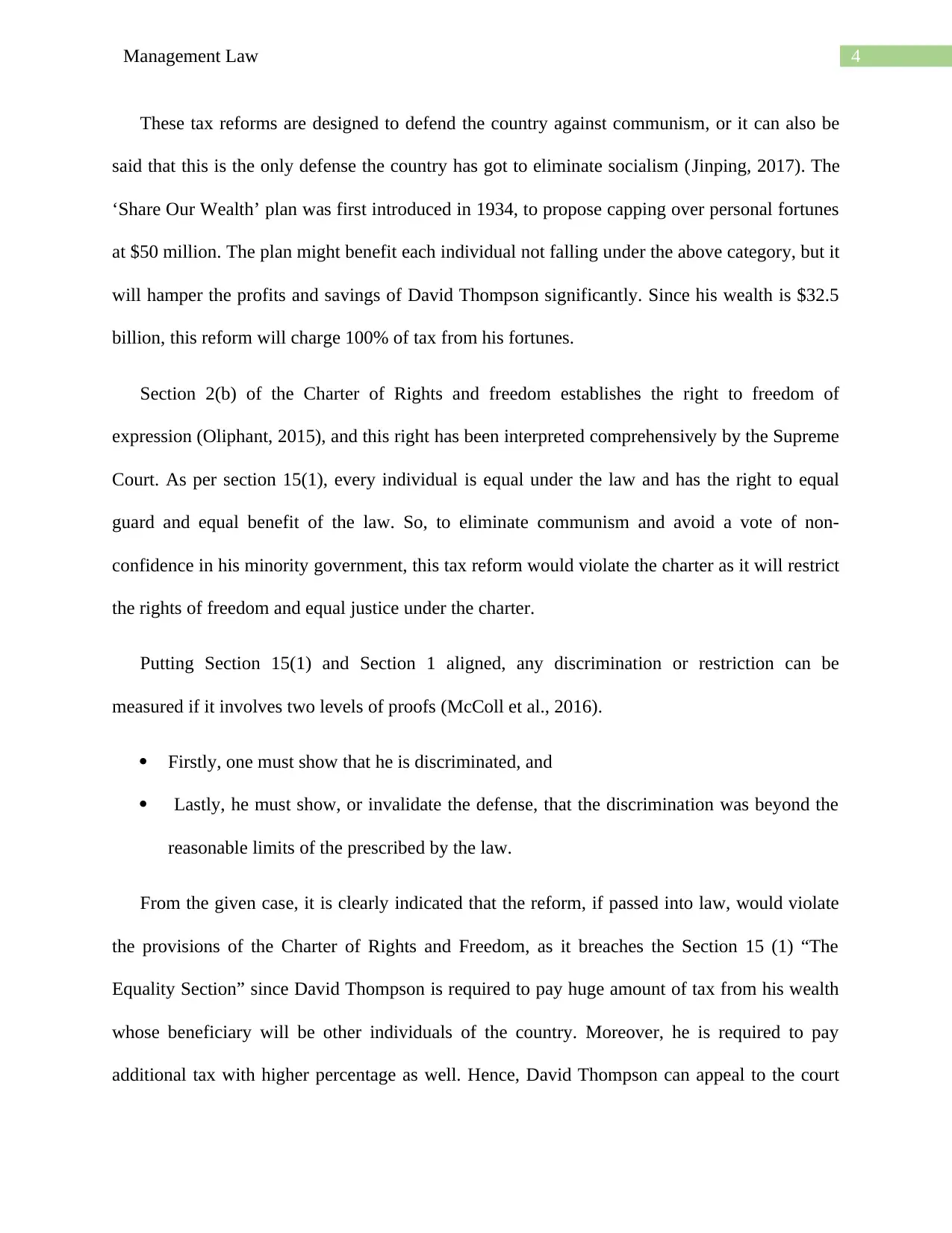
4Management Law
These tax reforms are designed to defend the country against communism, or it can also be
said that this is the only defense the country has got to eliminate socialism (Jinping, 2017). The
‘Share Our Wealth’ plan was first introduced in 1934, to propose capping over personal fortunes
at $50 million. The plan might benefit each individual not falling under the above category, but it
will hamper the profits and savings of David Thompson significantly. Since his wealth is $32.5
billion, this reform will charge 100% of tax from his fortunes.
Section 2(b) of the Charter of Rights and freedom establishes the right to freedom of
expression (Oliphant, 2015), and this right has been interpreted comprehensively by the Supreme
Court. As per section 15(1), every individual is equal under the law and has the right to equal
guard and equal benefit of the law. So, to eliminate communism and avoid a vote of non-
confidence in his minority government, this tax reform would violate the charter as it will restrict
the rights of freedom and equal justice under the charter.
Putting Section 15(1) and Section 1 aligned, any discrimination or restriction can be
measured if it involves two levels of proofs (McColl et al., 2016).
Firstly, one must show that he is discriminated, and
Lastly, he must show, or invalidate the defense, that the discrimination was beyond the
reasonable limits of the prescribed by the law.
From the given case, it is clearly indicated that the reform, if passed into law, would violate
the provisions of the Charter of Rights and Freedom, as it breaches the Section 15 (1) “The
Equality Section” since David Thompson is required to pay huge amount of tax from his wealth
whose beneficiary will be other individuals of the country. Moreover, he is required to pay
additional tax with higher percentage as well. Hence, David Thompson can appeal to the court
These tax reforms are designed to defend the country against communism, or it can also be
said that this is the only defense the country has got to eliminate socialism (Jinping, 2017). The
‘Share Our Wealth’ plan was first introduced in 1934, to propose capping over personal fortunes
at $50 million. The plan might benefit each individual not falling under the above category, but it
will hamper the profits and savings of David Thompson significantly. Since his wealth is $32.5
billion, this reform will charge 100% of tax from his fortunes.
Section 2(b) of the Charter of Rights and freedom establishes the right to freedom of
expression (Oliphant, 2015), and this right has been interpreted comprehensively by the Supreme
Court. As per section 15(1), every individual is equal under the law and has the right to equal
guard and equal benefit of the law. So, to eliminate communism and avoid a vote of non-
confidence in his minority government, this tax reform would violate the charter as it will restrict
the rights of freedom and equal justice under the charter.
Putting Section 15(1) and Section 1 aligned, any discrimination or restriction can be
measured if it involves two levels of proofs (McColl et al., 2016).
Firstly, one must show that he is discriminated, and
Lastly, he must show, or invalidate the defense, that the discrimination was beyond the
reasonable limits of the prescribed by the law.
From the given case, it is clearly indicated that the reform, if passed into law, would violate
the provisions of the Charter of Rights and Freedom, as it breaches the Section 15 (1) “The
Equality Section” since David Thompson is required to pay huge amount of tax from his wealth
whose beneficiary will be other individuals of the country. Moreover, he is required to pay
additional tax with higher percentage as well. Hence, David Thompson can appeal to the court
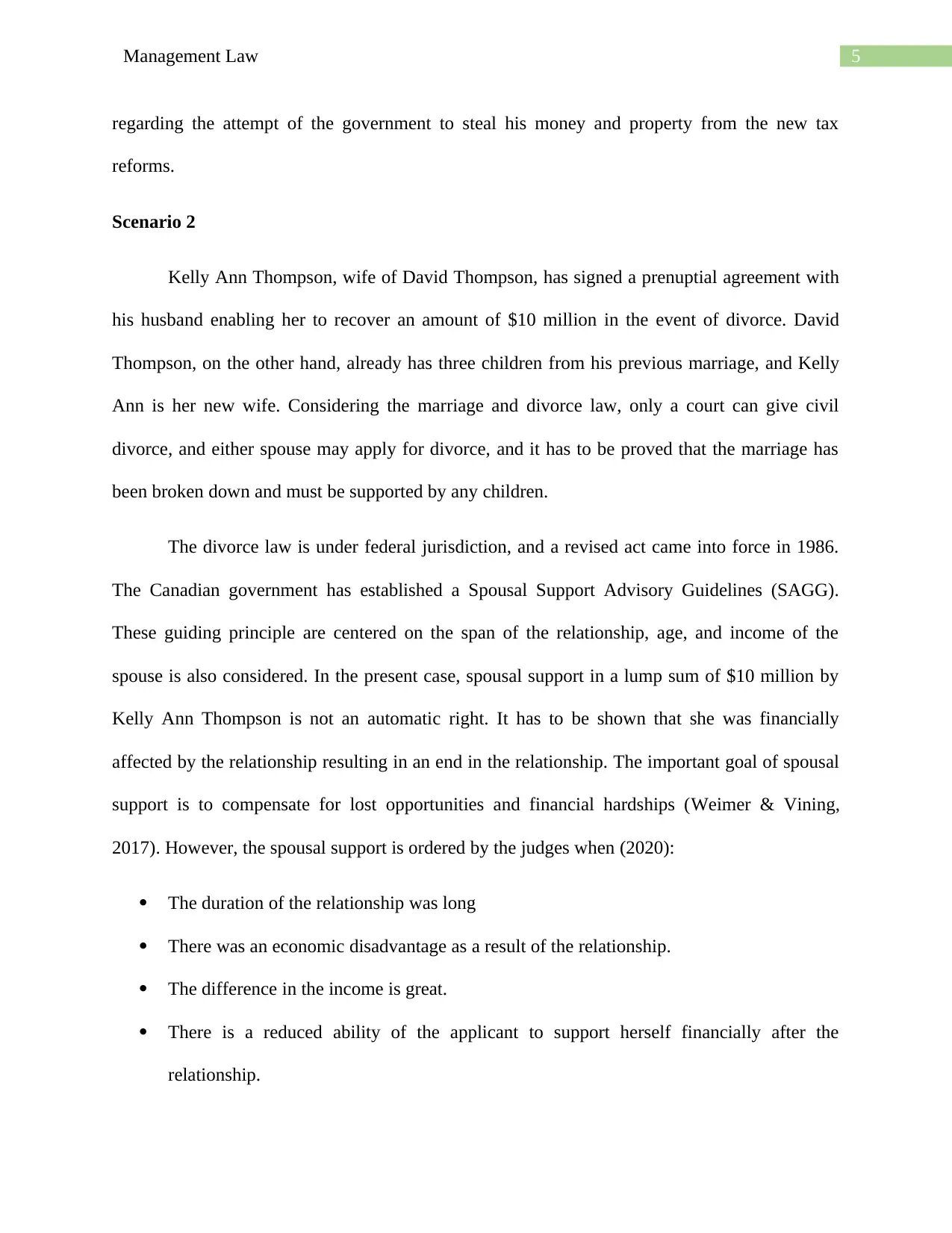
5Management Law
regarding the attempt of the government to steal his money and property from the new tax
reforms.
Scenario 2
Kelly Ann Thompson, wife of David Thompson, has signed a prenuptial agreement with
his husband enabling her to recover an amount of $10 million in the event of divorce. David
Thompson, on the other hand, already has three children from his previous marriage, and Kelly
Ann is her new wife. Considering the marriage and divorce law, only a court can give civil
divorce, and either spouse may apply for divorce, and it has to be proved that the marriage has
been broken down and must be supported by any children.
The divorce law is under federal jurisdiction, and a revised act came into force in 1986.
The Canadian government has established a Spousal Support Advisory Guidelines (SAGG).
These guiding principle are centered on the span of the relationship, age, and income of the
spouse is also considered. In the present case, spousal support in a lump sum of $10 million by
Kelly Ann Thompson is not an automatic right. It has to be shown that she was financially
affected by the relationship resulting in an end in the relationship. The important goal of spousal
support is to compensate for lost opportunities and financial hardships (Weimer & Vining,
2017). However, the spousal support is ordered by the judges when (2020):
The duration of the relationship was long
There was an economic disadvantage as a result of the relationship.
The difference in the income is great.
There is a reduced ability of the applicant to support herself financially after the
relationship.
regarding the attempt of the government to steal his money and property from the new tax
reforms.
Scenario 2
Kelly Ann Thompson, wife of David Thompson, has signed a prenuptial agreement with
his husband enabling her to recover an amount of $10 million in the event of divorce. David
Thompson, on the other hand, already has three children from his previous marriage, and Kelly
Ann is her new wife. Considering the marriage and divorce law, only a court can give civil
divorce, and either spouse may apply for divorce, and it has to be proved that the marriage has
been broken down and must be supported by any children.
The divorce law is under federal jurisdiction, and a revised act came into force in 1986.
The Canadian government has established a Spousal Support Advisory Guidelines (SAGG).
These guiding principle are centered on the span of the relationship, age, and income of the
spouse is also considered. In the present case, spousal support in a lump sum of $10 million by
Kelly Ann Thompson is not an automatic right. It has to be shown that she was financially
affected by the relationship resulting in an end in the relationship. The important goal of spousal
support is to compensate for lost opportunities and financial hardships (Weimer & Vining,
2017). However, the spousal support is ordered by the judges when (2020):
The duration of the relationship was long
There was an economic disadvantage as a result of the relationship.
The difference in the income is great.
There is a reduced ability of the applicant to support herself financially after the
relationship.
⊘ This is a preview!⊘
Do you want full access?
Subscribe today to unlock all pages.

Trusted by 1+ million students worldwide
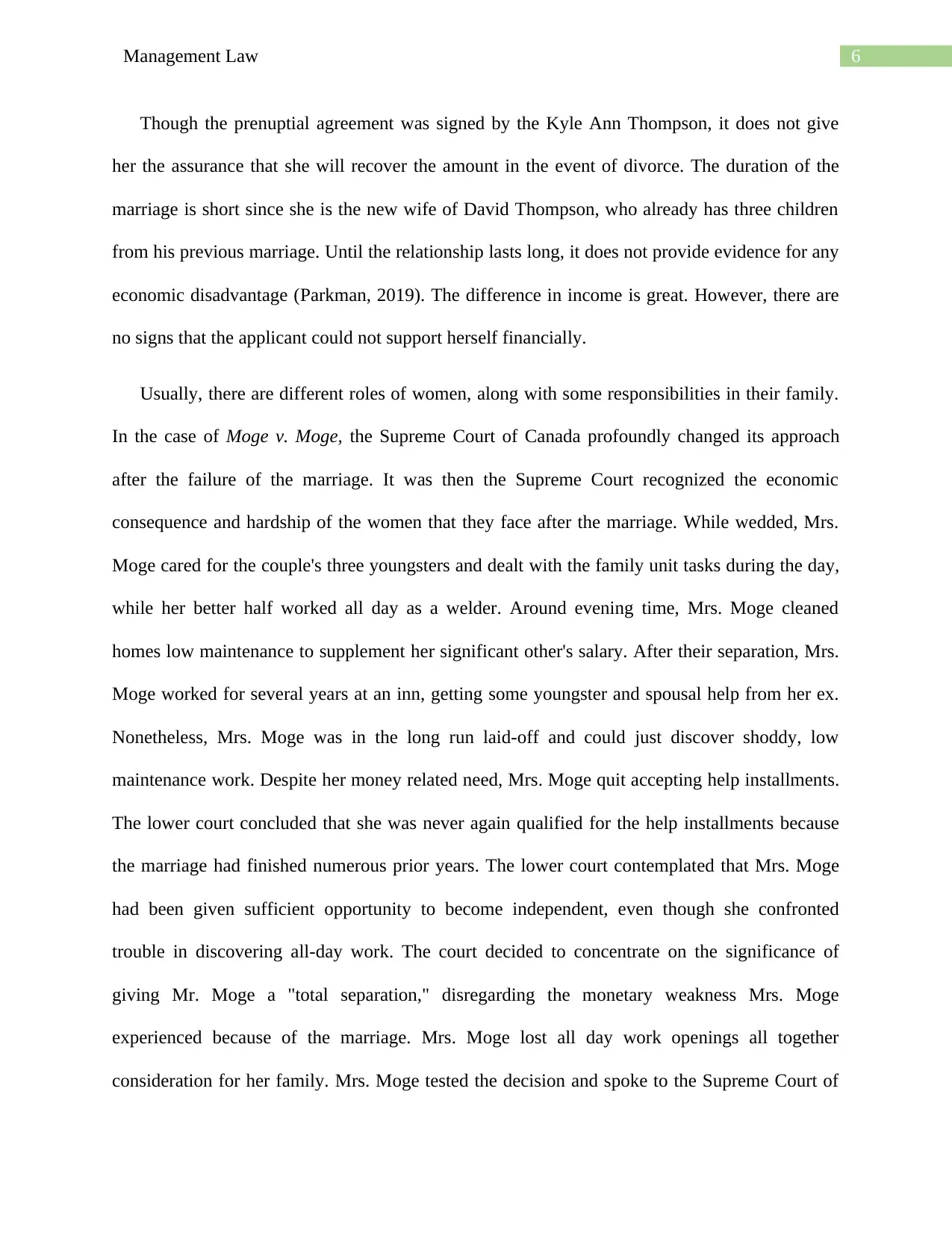
6Management Law
Though the prenuptial agreement was signed by the Kyle Ann Thompson, it does not give
her the assurance that she will recover the amount in the event of divorce. The duration of the
marriage is short since she is the new wife of David Thompson, who already has three children
from his previous marriage. Until the relationship lasts long, it does not provide evidence for any
economic disadvantage (Parkman, 2019). The difference in income is great. However, there are
no signs that the applicant could not support herself financially.
Usually, there are different roles of women, along with some responsibilities in their family.
In the case of Moge v. Moge, the Supreme Court of Canada profoundly changed its approach
after the failure of the marriage. It was then the Supreme Court recognized the economic
consequence and hardship of the women that they face after the marriage. While wedded, Mrs.
Moge cared for the couple's three youngsters and dealt with the family unit tasks during the day,
while her better half worked all day as a welder. Around evening time, Mrs. Moge cleaned
homes low maintenance to supplement her significant other's salary. After their separation, Mrs.
Moge worked for several years at an inn, getting some youngster and spousal help from her ex.
Nonetheless, Mrs. Moge was in the long run laid-off and could just discover shoddy, low
maintenance work. Despite her money related need, Mrs. Moge quit accepting help installments.
The lower court concluded that she was never again qualified for the help installments because
the marriage had finished numerous prior years. The lower court contemplated that Mrs. Moge
had been given sufficient opportunity to become independent, even though she confronted
trouble in discovering all-day work. The court decided to concentrate on the significance of
giving Mr. Moge a "total separation," disregarding the monetary weakness Mrs. Moge
experienced because of the marriage. Mrs. Moge lost all day work openings all together
consideration for her family. Mrs. Moge tested the decision and spoke to the Supreme Court of
Though the prenuptial agreement was signed by the Kyle Ann Thompson, it does not give
her the assurance that she will recover the amount in the event of divorce. The duration of the
marriage is short since she is the new wife of David Thompson, who already has three children
from his previous marriage. Until the relationship lasts long, it does not provide evidence for any
economic disadvantage (Parkman, 2019). The difference in income is great. However, there are
no signs that the applicant could not support herself financially.
Usually, there are different roles of women, along with some responsibilities in their family.
In the case of Moge v. Moge, the Supreme Court of Canada profoundly changed its approach
after the failure of the marriage. It was then the Supreme Court recognized the economic
consequence and hardship of the women that they face after the marriage. While wedded, Mrs.
Moge cared for the couple's three youngsters and dealt with the family unit tasks during the day,
while her better half worked all day as a welder. Around evening time, Mrs. Moge cleaned
homes low maintenance to supplement her significant other's salary. After their separation, Mrs.
Moge worked for several years at an inn, getting some youngster and spousal help from her ex.
Nonetheless, Mrs. Moge was in the long run laid-off and could just discover shoddy, low
maintenance work. Despite her money related need, Mrs. Moge quit accepting help installments.
The lower court concluded that she was never again qualified for the help installments because
the marriage had finished numerous prior years. The lower court contemplated that Mrs. Moge
had been given sufficient opportunity to become independent, even though she confronted
trouble in discovering all-day work. The court decided to concentrate on the significance of
giving Mr. Moge a "total separation," disregarding the monetary weakness Mrs. Moge
experienced because of the marriage. Mrs. Moge lost all day work openings all together
consideration for her family. Mrs. Moge tested the decision and spoke to the Supreme Court of
Paraphrase This Document
Need a fresh take? Get an instant paraphrase of this document with our AI Paraphraser
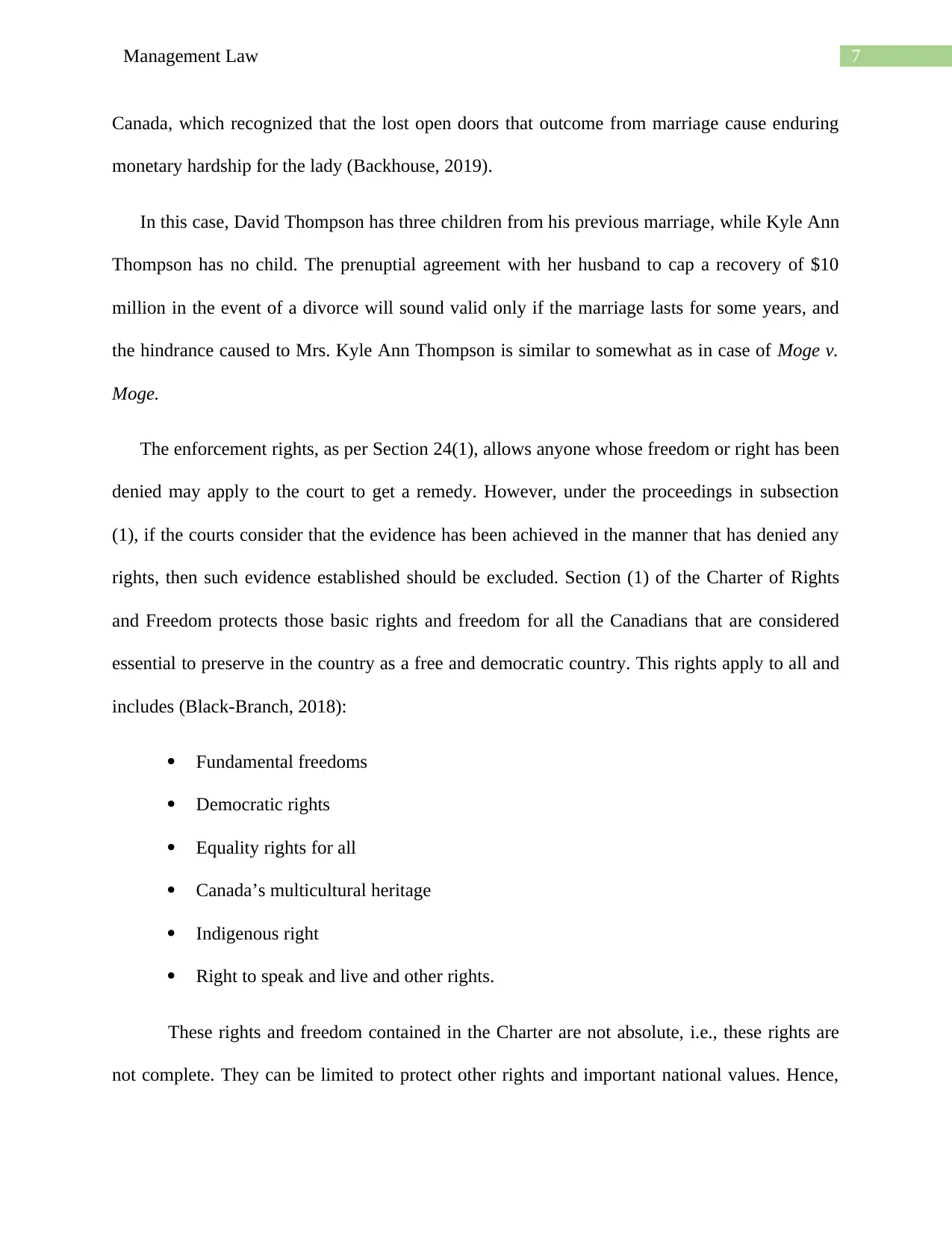
7Management Law
Canada, which recognized that the lost open doors that outcome from marriage cause enduring
monetary hardship for the lady (Backhouse, 2019).
In this case, David Thompson has three children from his previous marriage, while Kyle Ann
Thompson has no child. The prenuptial agreement with her husband to cap a recovery of $10
million in the event of a divorce will sound valid only if the marriage lasts for some years, and
the hindrance caused to Mrs. Kyle Ann Thompson is similar to somewhat as in case of Moge v.
Moge.
The enforcement rights, as per Section 24(1), allows anyone whose freedom or right has been
denied may apply to the court to get a remedy. However, under the proceedings in subsection
(1), if the courts consider that the evidence has been achieved in the manner that has denied any
rights, then such evidence established should be excluded. Section (1) of the Charter of Rights
and Freedom protects those basic rights and freedom for all the Canadians that are considered
essential to preserve in the country as a free and democratic country. This rights apply to all and
includes (Black-Branch, 2018):
Fundamental freedoms
Democratic rights
Equality rights for all
Canada’s multicultural heritage
Indigenous right
Right to speak and live and other rights.
These rights and freedom contained in the Charter are not absolute, i.e., these rights are
not complete. They can be limited to protect other rights and important national values. Hence,
Canada, which recognized that the lost open doors that outcome from marriage cause enduring
monetary hardship for the lady (Backhouse, 2019).
In this case, David Thompson has three children from his previous marriage, while Kyle Ann
Thompson has no child. The prenuptial agreement with her husband to cap a recovery of $10
million in the event of a divorce will sound valid only if the marriage lasts for some years, and
the hindrance caused to Mrs. Kyle Ann Thompson is similar to somewhat as in case of Moge v.
Moge.
The enforcement rights, as per Section 24(1), allows anyone whose freedom or right has been
denied may apply to the court to get a remedy. However, under the proceedings in subsection
(1), if the courts consider that the evidence has been achieved in the manner that has denied any
rights, then such evidence established should be excluded. Section (1) of the Charter of Rights
and Freedom protects those basic rights and freedom for all the Canadians that are considered
essential to preserve in the country as a free and democratic country. This rights apply to all and
includes (Black-Branch, 2018):
Fundamental freedoms
Democratic rights
Equality rights for all
Canada’s multicultural heritage
Indigenous right
Right to speak and live and other rights.
These rights and freedom contained in the Charter are not absolute, i.e., these rights are
not complete. They can be limited to protect other rights and important national values. Hence,
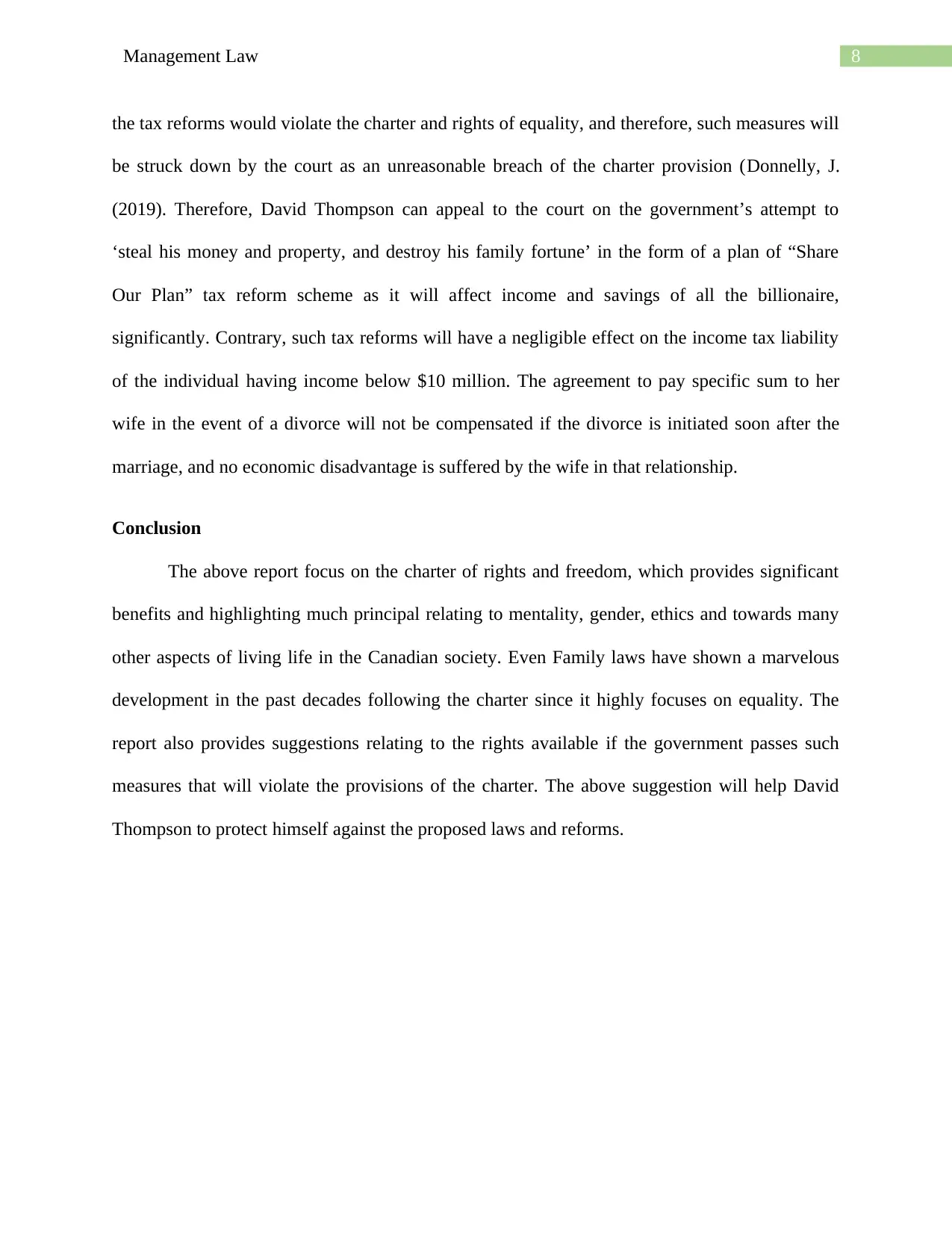
8Management Law
the tax reforms would violate the charter and rights of equality, and therefore, such measures will
be struck down by the court as an unreasonable breach of the charter provision (Donnelly, J.
(2019). Therefore, David Thompson can appeal to the court on the government’s attempt to
‘steal his money and property, and destroy his family fortune’ in the form of a plan of “Share
Our Plan” tax reform scheme as it will affect income and savings of all the billionaire,
significantly. Contrary, such tax reforms will have a negligible effect on the income tax liability
of the individual having income below $10 million. The agreement to pay specific sum to her
wife in the event of a divorce will not be compensated if the divorce is initiated soon after the
marriage, and no economic disadvantage is suffered by the wife in that relationship.
Conclusion
The above report focus on the charter of rights and freedom, which provides significant
benefits and highlighting much principal relating to mentality, gender, ethics and towards many
other aspects of living life in the Canadian society. Even Family laws have shown a marvelous
development in the past decades following the charter since it highly focuses on equality. The
report also provides suggestions relating to the rights available if the government passes such
measures that will violate the provisions of the charter. The above suggestion will help David
Thompson to protect himself against the proposed laws and reforms.
the tax reforms would violate the charter and rights of equality, and therefore, such measures will
be struck down by the court as an unreasonable breach of the charter provision (Donnelly, J.
(2019). Therefore, David Thompson can appeal to the court on the government’s attempt to
‘steal his money and property, and destroy his family fortune’ in the form of a plan of “Share
Our Plan” tax reform scheme as it will affect income and savings of all the billionaire,
significantly. Contrary, such tax reforms will have a negligible effect on the income tax liability
of the individual having income below $10 million. The agreement to pay specific sum to her
wife in the event of a divorce will not be compensated if the divorce is initiated soon after the
marriage, and no economic disadvantage is suffered by the wife in that relationship.
Conclusion
The above report focus on the charter of rights and freedom, which provides significant
benefits and highlighting much principal relating to mentality, gender, ethics and towards many
other aspects of living life in the Canadian society. Even Family laws have shown a marvelous
development in the past decades following the charter since it highly focuses on equality. The
report also provides suggestions relating to the rights available if the government passes such
measures that will violate the provisions of the charter. The above suggestion will help David
Thompson to protect himself against the proposed laws and reforms.
⊘ This is a preview!⊘
Do you want full access?
Subscribe today to unlock all pages.

Trusted by 1+ million students worldwide
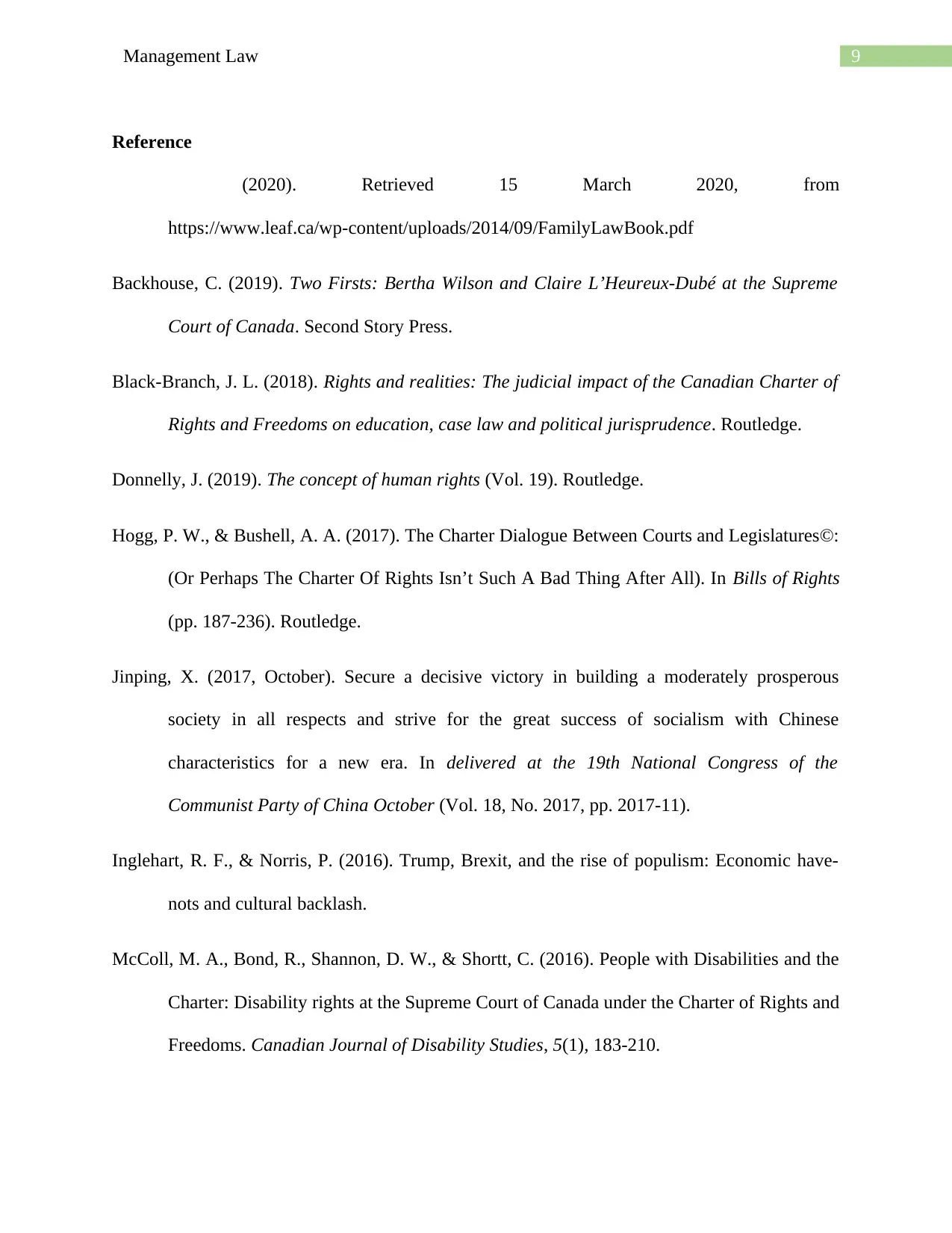
9Management Law
Reference
(2020). Retrieved 15 March 2020, from
https://www.leaf.ca/wp-content/uploads/2014/09/FamilyLawBook.pdf
Backhouse, C. (2019). Two Firsts: Bertha Wilson and Claire L’Heureux-Dubé at the Supreme
Court of Canada. Second Story Press.
Black-Branch, J. L. (2018). Rights and realities: The judicial impact of the Canadian Charter of
Rights and Freedoms on education, case law and political jurisprudence. Routledge.
Donnelly, J. (2019). The concept of human rights (Vol. 19). Routledge.
Hogg, P. W., & Bushell, A. A. (2017). The Charter Dialogue Between Courts and Legislatures©:
(Or Perhaps The Charter Of Rights Isn’t Such A Bad Thing After All). In Bills of Rights
(pp. 187-236). Routledge.
Jinping, X. (2017, October). Secure a decisive victory in building a moderately prosperous
society in all respects and strive for the great success of socialism with Chinese
characteristics for a new era. In delivered at the 19th National Congress of the
Communist Party of China October (Vol. 18, No. 2017, pp. 2017-11).
Inglehart, R. F., & Norris, P. (2016). Trump, Brexit, and the rise of populism: Economic have-
nots and cultural backlash.
McColl, M. A., Bond, R., Shannon, D. W., & Shortt, C. (2016). People with Disabilities and the
Charter: Disability rights at the Supreme Court of Canada under the Charter of Rights and
Freedoms. Canadian Journal of Disability Studies, 5(1), 183-210.
Reference
(2020). Retrieved 15 March 2020, from
https://www.leaf.ca/wp-content/uploads/2014/09/FamilyLawBook.pdf
Backhouse, C. (2019). Two Firsts: Bertha Wilson and Claire L’Heureux-Dubé at the Supreme
Court of Canada. Second Story Press.
Black-Branch, J. L. (2018). Rights and realities: The judicial impact of the Canadian Charter of
Rights and Freedoms on education, case law and political jurisprudence. Routledge.
Donnelly, J. (2019). The concept of human rights (Vol. 19). Routledge.
Hogg, P. W., & Bushell, A. A. (2017). The Charter Dialogue Between Courts and Legislatures©:
(Or Perhaps The Charter Of Rights Isn’t Such A Bad Thing After All). In Bills of Rights
(pp. 187-236). Routledge.
Jinping, X. (2017, October). Secure a decisive victory in building a moderately prosperous
society in all respects and strive for the great success of socialism with Chinese
characteristics for a new era. In delivered at the 19th National Congress of the
Communist Party of China October (Vol. 18, No. 2017, pp. 2017-11).
Inglehart, R. F., & Norris, P. (2016). Trump, Brexit, and the rise of populism: Economic have-
nots and cultural backlash.
McColl, M. A., Bond, R., Shannon, D. W., & Shortt, C. (2016). People with Disabilities and the
Charter: Disability rights at the Supreme Court of Canada under the Charter of Rights and
Freedoms. Canadian Journal of Disability Studies, 5(1), 183-210.
Paraphrase This Document
Need a fresh take? Get an instant paraphrase of this document with our AI Paraphraser
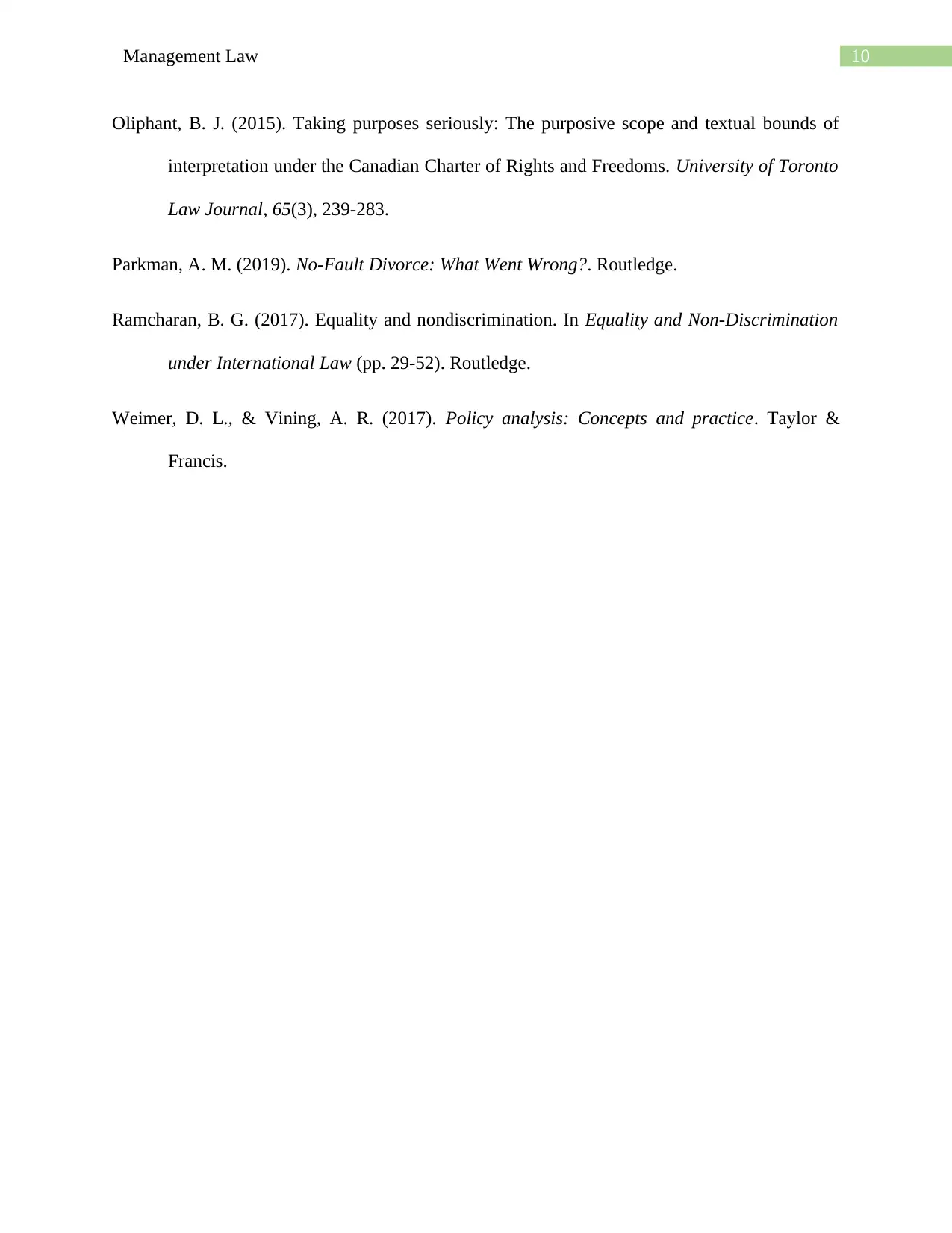
10Management Law
Oliphant, B. J. (2015). Taking purposes seriously: The purposive scope and textual bounds of
interpretation under the Canadian Charter of Rights and Freedoms. University of Toronto
Law Journal, 65(3), 239-283.
Parkman, A. M. (2019). No-Fault Divorce: What Went Wrong?. Routledge.
Ramcharan, B. G. (2017). Equality and nondiscrimination. In Equality and Non-Discrimination
under International Law (pp. 29-52). Routledge.
Weimer, D. L., & Vining, A. R. (2017). Policy analysis: Concepts and practice. Taylor &
Francis.
Oliphant, B. J. (2015). Taking purposes seriously: The purposive scope and textual bounds of
interpretation under the Canadian Charter of Rights and Freedoms. University of Toronto
Law Journal, 65(3), 239-283.
Parkman, A. M. (2019). No-Fault Divorce: What Went Wrong?. Routledge.
Ramcharan, B. G. (2017). Equality and nondiscrimination. In Equality and Non-Discrimination
under International Law (pp. 29-52). Routledge.
Weimer, D. L., & Vining, A. R. (2017). Policy analysis: Concepts and practice. Taylor &
Francis.
1 out of 11
Related Documents
Your All-in-One AI-Powered Toolkit for Academic Success.
+13062052269
info@desklib.com
Available 24*7 on WhatsApp / Email
![[object Object]](/_next/static/media/star-bottom.7253800d.svg)
Unlock your academic potential
Copyright © 2020–2025 A2Z Services. All Rights Reserved. Developed and managed by ZUCOL.





